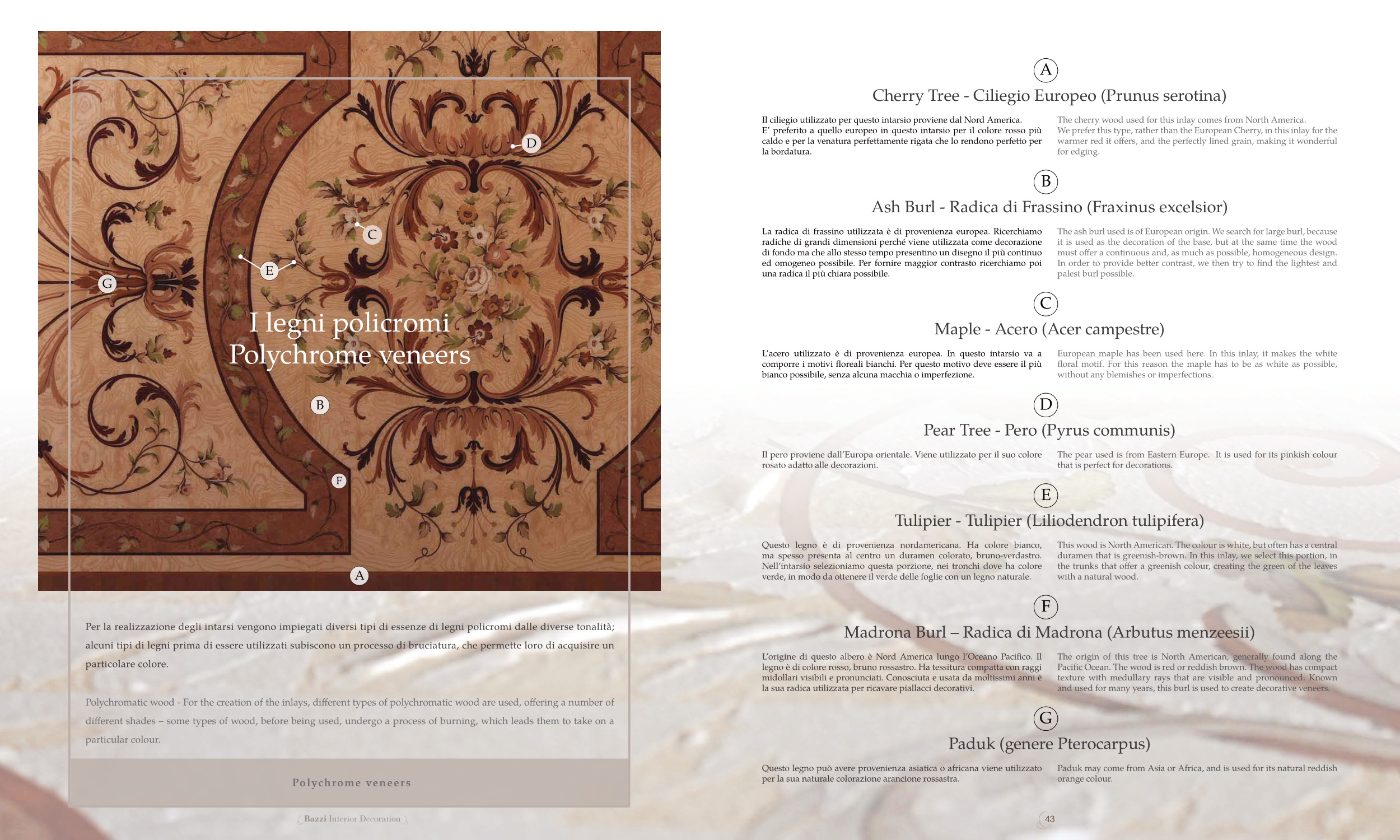I legni policromi
Polychrome veneers
F
G
B
D
E
C
Polychrome veneers
Per la realizzazione degli intarsi vengono impiegati diversi tipi di essenze di legni policromi dalle diverse tonalità;
alcuni tipi di legni prima di essere utilizzati subiscono un processo di bruciatura, che permette loro di acquisire un
particolare colore.
Polychromatic wood - For the creation of the inlays, different types of polychromatic wood are used, offering a number of
different shades – some types of wood, before being used, undergo a process of burning, which leads them to take on a
particular colour.
Cherry Tree - Ciliegio Europeo (Prunus serotina)
Il ciliegio utilizzato per questo intarsio proviene dal Nord America.
E’ preferito a quello europeo in questo intarsio per il colore rosso più
caldo e per la venatura perfettamente rigata che lo rendono perfetto per
la bordatura.
The cherry wood used for this inlay comes from North America.
We prefer this type, rather than the European Cherry, in this inlay for the
warmer red it offers, and the perfectly lined grain, making it wonderful
for edging.
A
Ash Burl - Radica di Frassino (Fraxinus excelsior)
La radica di frassino utilizzata è di provenienza europea. Ricerchiamo
radiche di grandi dimensioni perché viene utilizzata come decorazione
di fondo ma che allo stesso tempo presentino un disegno il più continuo
ed omogeneo possibile. Per fornire maggior contrasto ricerchiamo poi
una radica il più chiara possibile.
The ash burl used is of European origin. We search for large burl, because
it is used as the decoration of the base, but at the same time the wood
must offer a continuous and, as much as possible, homogeneous design.
In order to provide better contrast, we then try to find the lightest and
palest burl possible.
B
Maple - Acero (Acer campestre)
L’acero utilizzato è di provenienza europea. In questo intarsio va a
comporre i motivi floreali bianchi. Per questo motivo deve essere il più
bianco possibile, senza alcuna macchia o imperfezione.
European maple has been used here. In this inlay, it makes the white
floral motif. For this reason the maple has to be as white as possible,
without any blemishes or imperfections.
C
Pear Tree - Pero (Pyrus communis)
Il pero proviene dall’Europa orientale. Viene utilizzato per il suo colore
rosato adatto alle decorazioni.
The pear used is from Eastern Europe. It is used for its pinkish colour
that is perfect for decorations.
D
Tulipier - Tulipier (Liliodendron tulipifera)
Questo legno è di provenienza nordamericana. Ha colore bianco,
ma spesso presenta al centro un duramen colorato, bruno-verdastro.
Nell’intarsio selezioniamo questa porzione, nei tronchi dove ha colore
verde, in modo da ottenere il verde delle foglie con un legno naturale.
This wood is North American. The colour is white, but often has a central
duramen that is greenish-brown. In this inlay, we select this portion, in
the trunks that offer a greenish colour, creating the green of the leaves
with a natural wood.
E
F
Madrona Burl – Radica di Madrona (Arbutus menzeesii)
L’origine di questo albero è Nord America lungo l’Oceano Pacifico. Il
legno è di colore rosso, bruno rossastro. Ha tessitura compatta con raggi
midollari visibili e pronunciati. Conosciuta e usata da moltissimi anni è
la sua radica utilizzata per ricavare piallacci decorativi.
The origin of this tree is North American, generally found along the
Pacific Ocean. The wood is red or reddish brown. The wood has compact
texture with medullary rays that are visible and pronounced. Known
and used for many years, this burl is used to create decorative veneers.
G
Paduk (genere Pterocarpus)
Questo legno può avere provenienza asiatica o africana viene utilizzato
per la sua naturale colorazione arancione rossastra.
Paduk may come from Asia or Africa, and is used for its natural reddish
orange colour.
43
Bazzi Interior Decoration


